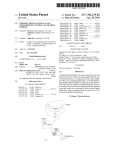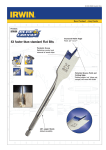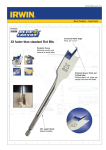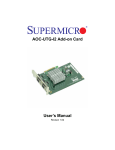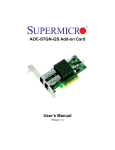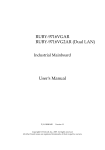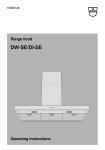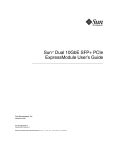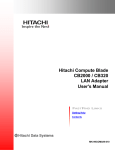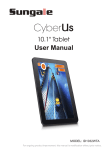Download AOC-UG-i4 - Supermicro
Transcript
AOC-UG-i4 USER'S GUIDE Rev. 1.0 Add-on Card User's Guide The information in this User’s Manual has been carefully reviewed and is believed to be accurate. The vendor assumes no responsibility for any inaccuracies that may be contained in this document, makes no commitment to update or to keep current the information in this manual, or to notify any person or organization of the updates. Please Note: For the most up-to-date version of this manual, please see our web site at www.supermicro.com. SUPERMICRO COMPUTER reserves the right to make changes to the product described in this manual at any time and without notice. This product, including software, if any, and documentation may not, in whole or in part, be copied, photocopied, reproduced, translated or reduced to any medium or machine without prior written consent. IN NO EVENT WILL SUPERMICRO COMPUTER BE LIABLE FOR DIRECT, INDIRECT, SPECIAL, INCIDENTAL, SPECULATIVE OR CONSEQUENTIAL DAMAGES ARISING FROM THE USE OR INABILITY TO USE THIS PRODUCT OR DOCUMENTATION, EVEN IF ADVISED OF THE POSSIBILITY OF SUCH DAMAGES. IN PARTICULAR, THE VENDOR SHALL NOT HAVE LIABILITY FOR ANY HARDWARE, SOFTWARE, OR DATA STORED OR USED WITH THE PRODUCT, INCLUDING THE COSTS OF REPAIRING, REPLACING, INTEGRATING, INSTALLING OR RECOVERING SUCH HARDWARE, SOFTWARE, OR DATA. Any disputes arising between manufacturer and customer shall be governed by the laws of Santa Clara County in the State of California, USA. The State of California, County of Santa Clara shall be the exclusive venue for the resolution of any such disputes. Supermicro's total liability for all claims will not exceed the price paid for the hardware product. Manual Revision 1.0 Release Date: March 1, 2007 Unless you request and receive written permission from SUPER MICRO COMPUTER, you may not copy or otherwise reproduce/distribute any part of this document. Information in this document is subject to change without notice. Other products and companies referred to herein are trademarks or registered trademarks of their respective companies or mark holders. Chapters 3 and 4 of this manual were taken directly from the Intel® PRO/1000 Server Adapter Guide included with the Adapter Driver CD. These sections were used with permission. Copyright © 2007 by SUPER MICRO COMPUTER INC. All rights reserved. Printed in the United States of America ii Safety Information and Technical Specifications Table of Contents Introduction Overview .............................................................................................................v Product Features.................................................................................................v Supported Operating Systems, Motherboards, and Servers ..............................v Manual Images....................................................................................................v Contacting SuperMicro .......................................................................................vi Chapter 1 Safety Guidelines 1-1 ESD Safety Guidelines ................................................................................... 1-1 1-2 General Safety Guidelines .............................................................................. 1-1 1-3 An Important Note to Users ............................................................................ 1-1 Chapter 2 Add-on Card Components 2-1 Front Connectors, Jumpers, and LEDs .......................................................... 2-1 Components .................................................................................................... 2-1 2-2 Front Connector and Jumper Definitions ........................................................ 2-2 Explanation of Jumpers .............................................................................. 2-3 Chapter 3 Installing the Drivers 3-1 Install the Drivers in Microsoft Windows.............................................................. 3-1 3-2 Intel® PROSet for Windows* Device Manager ................................................... 3-2 Installing Intel PROSet for Windows Device Manager ................................... 3-2 Tips for PROSet Users............................................................................... 3-2 Removing Intel PROSet for Windows Device Manager ................................. 3-2 Receive Side Scaling ...................................................................................... 3-3 RSS Configuration...................................................................................... 3-3 Teaming ...................................................................................................... 3-3 3-3 Installing the Base Driver and Intel® PROSet via the Command Line ............... 3-4 Installation Methods ........................................................................................ 3-4 Base Driver Installation ................................................................................... 3-4 Command Line Options ............................................................................. 3-4 Intel PROSet for Windows Device Manager Installation ................................ 3-5 Using the DxSetup.exe utility ..................................................................... 3-6 Command line examples ............................................................................ 3-7 msiexec.exe command line options ........................................................... 3-7 Command Line Switches ................................................................................ 3-8 Silent install/upgrade command line syntax ............................................... 3-9 iii Add-on Card User's Guide Silent uninstall command line syntax ......................................................... 3-9 Command line options supported by PROSETDX.msi .............................. 3-9 Command line install examples ............................................................... 3-10 Command line uninstall example ..............................................................3-11 Command line reinstall / repair ................................................................ 3-12 Chapter 4 Linux Base Driver for PRO/1000 Family of Adapters 4-1 Overview .............................................................................................................. 4-1 4-2 Identifying Your Adapter ....................................................................................... 4-2 4-3 Building and Installation ....................................................................................... 4-2 4-4 Command Line Parameters ................................................................................. 4-4 Notes on InterruptThrottleRate ..................................................................4-11 Speed and Duplex Configuration ............................................................. 4-13 4-5 Additional Configurations ................................................................................... 4-14 Configuring the Driver on Different Distributions .......................................... 4-14 Viewing Link Messages ............................................................................ 4-15 Jumbo Frames ......................................................................................... 4-15 Ethtool ...................................................................................................... 4-16 Enabling Wake on LAN* (WoL) ................................................................ 4-17 NAPI ......................................................................................................... 4-17 iv Safety Information and Technical Specifications Introduction Overview This manual is written for system integrators, PC technicians and knowledgeable PC users who intend to integrate SuperMicro's AOC-UG-I4 Add on Card to their system. Product Features The AOC-UG-I4 offers the following features: • Dual Intel 82571 LAN chips • PCI-e x8 interface through PLX PCI-e 8518 • Full height PCI-e x8 UIO card that is optimized for our UIO motherboards and servers • Four Ports that maximize connectivity in small spaces through RJ45 connectors • Duel Intel 82571 (Ophir) LAN chips that ensure priority performance on each port without bus sharing • Intel's I/OAT accelorates I/O with higher throughput and lower CPU utilzation • Virtualization provides the platform with port density required for virtualized environments • Support Pre-boot Execution Environment (PXE) on Super Micro UIO motherboards and servers • Wake on LAN (WOL) support (Port A only) • RoHS 6/6 • Intel PROSet Utility for Windows supported network teaming Supported Operating Systems, Motherboards, and Servers The AOC-UG-I4 supports the following Operating Systems (OS) with the latest BIOS: • Windows 2000/Windows XP/Windows 2003 • Red Hat Enterprise Linux/SUSE Linux Manual Images All images and layouts shown are based upon the latest revision at the time of publishing. The card you receive not look exactly the same. v Add-on Card User's Guide Contacting SuperMicro Headquarters Address: SuperMicro Computer, Inc. 980 Rock Ave. San Jose, CA 95131 U.S.A. Tel: +1 (408) 503-8000 Fax: +1 (408) 503-8008 Email: [email protected] (General Information) [email protected] (Technical Support) Web Site: www.supermicro.com Europe Address: SuperMicro Computer B.V. Het Sterrenbeeld 28, 5215 ML 's-Hertogenbosch, The Netherlands Tel: +31 (0) 73-6400390 Fax: +31 (0) 73-6416525 Email: [email protected] (General Information) [email protected] (Technical Support) [email protected] (Customer Support) Asia-Pacific Address: SuperMicro, Taiwan 4F, No. 232-1, Liancheng Rd. Chung-Ho 235, Taipei County Taiwan, R.O.C. Tel: +886-(2) 8226-3990 Fax: +886-(2) 8226-3991 Web Site: www.supermicro.com.tw Technical Support: Email: [email protected] Tel: 886-2-8228-1366, ext.132 or 139 vi Safety Information and Technical Specifications Chapter 1 Safety Guidelines To avoid personal injury and property damage, carefully follow all the safety steps listed below when accessing your system or handling the components. 1-1 ESD Safety Guidelines Electric Static Discharge (ESD) can damage electronic components. To prevent damage to your system, it is important to handle it very carefully. The following measures are generally sufficient to protect your equipment from ESD. • Use a grounded wrist strap designed to prevent static discharge. • Touch a grounded metal object before removing a component from the antistatic bag. • Handle the add-on card by its edges only; do not touch its components, peripheral chips, memory modules or gold contacts. • When handling chips or modules, avoid touching their pins. • Put the card and peripherals back into their antistatic bags when not in use. 1-2 • General Safety Guidelines Always disconnect power cables before installing or removing any components from the computer. • Disconnect the power cable before installing or removing any cables from the system. • Make sure that the add-on card is securely and properly installed on the motherboard to prevent damage to the system due to power shortage. 1-3 • An Important Note to Users All images and layouts shown in this user's guide are based upon the latest PCB Revision available at the time of publishing. The card you have received may or may not look exactly the same as the graphics shown in this manual. 1-1 Add-on Card User's Guide Notes 1-2 Safety Information and Technical Specifications Chapter 2 Add-on Card Components 2-1 Front Connectors, Jumpers, and LEDs 62 42 52 22 32 02 12 81 91 61 71 41 51 21 31 01 9 8 7 6 5 4 3 1 2 1 11 T1 U8 Dual Port 82571 LAN Chip U7 A B C D E F G H J K L M N P R T U V W Y AA BA CA DA EA FA U9 Port A U10 T2 Port B T3 62 42 52 22 32 02 12 81 91 61 71 41 51 21 31 01 9 8 7 6 5 4 3 2 1 62 11 42 52 02 12 81 91 61 71 41 51 21 31 01 9 8 7 6 5 4 3 2 1 11 3 U13 Port C U15 A B C D E F G H J K L M N P R T U V W Y AA BA CA DA EA FA U12 A B C D E F G H J K L M N P R T U V W Y AA BA CA DA EA FA 22 32 U14 T4 PLX PCI-e switch 8518 Activity LED 2 Status LED Components 1. LAN Connector Ports 2. LAN Port LEDs 3. J2 Jumper: Wake on LAN 2-1 Port D Add-on Card User's Guide 2-2 Front Connector and Jumper Definitions 1. LAN ports LAN ports allow the Add-on card to connect to a maximum of four network cables. These are RJ45 connectors. Each LAN port provides up to one gigabit per second connection speed which require CAT6 cables for maximum throughput. The ports are designated port A, port B, port C, and port D. 2. LAN Port LEDs Each LAN port includes two LEDs: Activity and Status (link). GLAN Activity LED Color Status Amber Flashing Definition Active GLAN Link LED Color 2-2 Status Definition None Off No connectivity (or 10 Mbps Green On 100 Mbps Orange On 1 Gbps Safety Information and Technical Specifications 3. J2 Jumper: Wake on LAN When properly configured, this add-on card allows Network Administrators to use Wake on LAN. In addition to configurations required by your motherboard and software, you must close th J2 jumper on the add-on card to enable this feature. Jumper Settings Jumper WOL Enable Jumper Settings Closed = Enabled Note Wake on LAN enabled. (Default) Explanation of Jumpers To modify the operation of the backplane, 2 1 2 1 Connector Pins jumpers can be used to choose between optional settings. Jumpers create shorts between two pins to change the function Jumper of the connector. Pin 1 is identified with a square solder pad on the printed circuit board. Note: On two pin jumpers, "Closed" means the jumper is on and "Open" means the jumper is off the pins. 2-3 Setting Add-on Card User's Guide Notes 2-4 Safety Information and Technical Specifications Chapter 3 Installing the Drivers 3-1 Install the Drivers in Microsoft Windows NOTES: ● These instructions apply to all versions of Microsoft* Windows* 2000, Windows XP (including Windows XP x64 and Windows XP 64-bit Edition), Windows Vista* (including Windows Vista x64), and Windows Server* 2003 (including Windows Server 2003 x64 and Windows Server 2003 64-Bit Edition). ● This will update the drivers for all supported Intel® PRO network adapters in your system. Before installing or updating the drivers, insert your adapter(s) in the computer and plug in the network cable. When Windows discovers the new adapter, it attempts to find an acceptable Windows driver already installed with the operating system. If found, the driver is installed without any user intervention. If Windows cannot find the driver, the Found New Hardware Wizard window is displayed. Regardless of whether or not Windows finds the driver, it is recommended that you follow the procedure below to install the driver. Drivers for all Intel adapters supported by this software release are installed. 1. If you are installing drivers from the Product CD, insert the CD. If you do not have the Product CD, download drivers from the support website and transfer them to the system. 2. If the Found New Hardware Wizard screen is displayed, click Cancel. 3. Start the autorun located on the CD. If you downloaded the software package from the support website, the autorun automatically runs after you have extracted the files. 4. Click Install Drivers. 5. Follow the instructions in the install wizard. 3-1 Add-on Card User's Guide 3-2 Intel® PROSet for Windows* Device Manager Intel® PROSet for Windows* Device Manager is an extension to the Windows Device Manager. When you install the Intel PROSet software, additional tabs are automatically added to Device Manager. You can install Intel PROSet on computers running Microsoft* Windows* 2000, Windows XP, Windows Vista*, and Windows Server* 2003, including 64-bit and x64 versions. NOTE: You must have administrator rights to install or use Intel PROSet for Windows Device Manager. Installing Intel PROSet for Windows Device Manager Intel PROSet for Windows Device Manager is installed from the Product CD with the same process used to install drivers. You can select Intel PROSet for Windows Device Manager and Advanced Network Services from the Install Options dialog. Tips for PROSet Users If you have used prior versions of Intel PROSet, you should be aware of the following changes with Intel PROSet for Windows Device Manager: 1. There is no system tray icon. 2. The configuration utility is not accessible from the Control Panel or the Start menu. 3. All Intel PROSet features are now accessed from Device Manager. To access features, simply open the Device Manager and double-click the Intel adapter you would like to configure. Removing Intel PROSet for Windows Device Manager Use Add/Remove programs from the Control Panel to uninstall Intel PROSet for Windows Device Manager. 3-2 Safety Information and Technical Specifications Receive Side Scaling RSS must be enabled for Intel® I/O Acceleration Technology to function. You must install Microsoft’s Scalable Networking Pack (SNP) for RSS to function. Intel® PROSet will not display the RSS setting if SNP is not installed. NOTE: The Scalable Networking Pack is part of Microsoft* Windows* Server* 2003 Service Pack 2. It is not part of SP1 and requires a separate download. See http://www.microsoft.com for more information. RSS Configuration RSS is enabled on the Advanced tab of the adapter property sheet. If your adapter does not support RSS, or if the SNP is not installed, the RSS setting will not be displayed. Teaming If RSS is not enabled for all adapters in a team, RSS will be disabled for the team. If an adapter that does not support RSS is added to a team, RSS will be disabled for the team. If a non-Intel adapter is added to a team, RSS will be disabled for the team. Non-Intel adapters with RSS enabled cannot be added to a team. 3-3 Add-on Card User's Guide 3-3 Installing the Base Driver and Intel® PROSet via the Command Line Installation Methods The base driver install utility (SetupBD.exe) allows unattended install of base drivers from a command line. Intel® PROSet for Windows* Device Manager is supported on Microsoft* Windows* 2000, Windows XP, Windows Vista, and Microsoft Windows Server* 2003. Use DxSetup.exe to Install PROSet for Windows Device Manager. NOTE: Windows XP x64 and Windows Server 2003 x64 do not support unattended driver installation. Base Driver Installation Command Line Options SetupBD.exe supports the following command line switches. NOTE: You must include a space between switches. Switch Description /s silent install with no reboot /r force reboot (must be used with the /s switch) /nr no reboot (must be used with the /s switch. This switch is ignored if it is included with the /r switch) /u uninstall /infdir directory_ name search for inf and driver files only in the specified directory 3-4 Safety Information and Technical Specifications Option SetupBD SetupBD /s SetupBD /s /r Description Installs and/or updates the driver(s) and displays the GUI. Installs and/or updates the driver(s) silently. Installs and/or updates the driver(s) silently and forces a reboot. SetupBD /s /r Installs and/or updates the driver(s) silently and forces /nr a reboot (/nr is ignored). SetupBD /u Uninstalls all drivers from the system. SetupBD /infdir Installs and/or updates the driver(s), looks for inf and x:\infdir driver files only in the specified directory NOTES: * If you uninstall an adapter’s driver from Windows Device Manager, you must reboot before using SetupBD.exe to install a new driver. * If you install drivers on a system based on the Intel® 5000 Series Chipset, the /s switch (silent install) forces a reboot without the /r switch. If you do not want the system to reboot, use the /nr switch. * For Intel® I/O Acceleration Technology to function properly, you must reboot after driver installation. You can use the /r and /nr switches only with a silent install (i.e. with the “/s” option). Intel PROSet for Windows Device Manager Installation This section describes how to install Intel PROSet for Windows Device Manager from the command line. NOTE: Intel PROSet can be installed with DxSetup.exe or msiexec.exe. Intel recommends using DxSetup.exe. DxSetup.exe detects the system’s language, searches for the appropriate transform file, and applies it to MSI package. The transform file translates the installation instructions to the language associated with your operating system. 3-5 Add-on Card User's Guide Using the DxSetup.exe utility DxSetup.exe is a setup utility used for installing Intel PROSet. It detects the system language, searches for the appropriate transform file in the same folder, and then launches PROSETDX.msi in the language specific to the operating system. The transform file translates the installation instructions to the language associated with your operating system. DxSetup.exe also takes the install options from the command line and applies them to the PROSETDX.msi command line installation. DxSetup.exe command line switches: Switch Description silent install options. /q[r|n] r Reduced GUI Install n Silent install log file option. /l[i|w|e|a] i log status messages. w log non-fatal warnings. e log error messages. a log the start of all actions. DxSetup.exe Public Properties Switch Description “0”, deselect / do not execute SetupBD. “1”, execute SetupBD to install the drivers (default set- BD ting). NOTE: BD should only be set to 0 if the Base Drivers have already been installed prior to running DxSetup. exe ANS DMIX “0”, deselect / hide ANS. “1”, select ANS (default setting). “0”, deselect / hide Intel PROSet feature. “1”, select Intel PROSet feature (default setting). 3-6 Safety Information and Technical Specifications NOTES: The ANS property should only be set to ANS=1 if DMIX=1 is set. If DMIX=0 and ANS=1, the ANS=1 is ignored and only the base driver will be installed. Public properties are case sensitive. All characters are uppercase with no white space between characters. For example: DxSetup.exe /qn ANS=1 Any white space in “ANS=1” makes the setting invalid. “ans=1” is not a valid setting. Command line examples You can modify the paths for different operating systems and CD layouts and apply the command line examples. 1. The following launches a typical install silently: DxSetup.exe /qn /liew C:\install.log NOTE: BD, ANS and DMIX are selected by default. 2. How to install components but deselect ANS. Set the ANS=0 in the command line: DxSetup.exe /qn ANS=0 /liew C:\install.log msiexec.exe command line options Refer to Microsoft’s website for the most current information on msiexec.exe command line options: http://msdn.microsoft.com/library NOTES: * Not all command line options Microsoft provides with msiexec.exe have been tested or are necessarily supported for Intel PROSet installation. * Msiexec also sets an error level on return that corresponds to system error codes: http://msdn.microsoft.com/library 3-7 Add-on Card User's Guide This section describes how to install Intel PROSet for Windows Device Manager from the command line. It describes all the command line options supported in PROSETDX.msi. NOTE: Intel PROSet can be installed with DxSetup.exe or msiexec.exe. Intel recommends using DxSetup.exe. DxSetup.exe detects the system’s language, searches for the appropriate transform file, and applies it to MSI package. The transform file translates the installation instructions to the language associated with your operating system. Command Line Switches This section describes how to install Intel PROSet using PROSETDX.msi and msiexec.exe from the command line. For more information on msiexec.exe command line parameters, refer to the msiexec.exe command line options section. Windows Installer Service is installed by default in Windows 2000, XP32 and XP64. msiexec.exe is under System32 folder. When System32 is not in the current PATH, the full path to msiexec.exe should be specified in the command line. For example: C:\WINNT\System32\msiexec.exe /i PROSETDX.msi /qn /liew c:\temp\install.log Most commonly used msiexec.exe command line options: Switch Description /i install /x uninstall silent install options /q[r|n] r Reduced GUI Install n Silent install log file option. /l[i|w|e|a] i log status messages. w log non-fatal warnings. e log error messages. a log the start of all actions. A property used to apply transforms (a .mst file) to an MSI package. The following example applies a Chinese Transforms language transform to MSI package, so the installer displays Chinese strings during installation: TRANSFORMS=2052.mst 3-8 Safety Information and Technical Specifications Silent install/upgrade command line syntax The following launches a typical installation of PROSETDX.msi. <Full path to msiexec.exe> /i <Full path to PROSETDX.msi> /qn /liew <Full path to install.log> Silent uninstall command line syntax The following uninstalls all the Intel PROSet components. It can be used when the path to PROSETDX.msi is available. <path to msiexec.exe> /x <path to PROSETDX.msi> /qn /liew <path to uninstall. log> The following uninstalls all the Intel PROSet components. It can be used when the path to PROSETDX.msi is not available but the ProductCode of MSI package is known. <path to msiexec.exe> /x <ProductCode of PROSETDX.msi> /qn /liew <path to uninstall.log> Command line options supported by PROSETDX.msi PROSETDX.msi provides public properties that can be used to change Intel PROSet install selections from the command line. By setting the properties in the command line, you can disable and hide some features in PROSETDX.msi, or force some feature to be selected/displayed. This provides the flexibility to install different components/features in Intel PROSet. 3-9 Add-on Card User's Guide Following is the list of public properties provided by PROSETDX.msi: Property Definition “0”, deselect / do not execute SetupBD. “1”, execute SetupBD to install the drivers. NOTE: In this release, it is set to “1” by default. It is BD always installed by default in this release. BD should only be set to 0 if the Base Drivers have already been installed prior to running PROSETDX.msi “0”, deselect / hide ANS. “1”, select ANS. ANS NOTE: In this release, it is set to “1” by default. It is always installed by default in this release. “0”, deselect / hide Intel PROSet feature. “1”, select Intel PROSet feature. DMIX NOTE: In this release, it is set to “1” by default. It is always installed by default in this release. NOTES: * The ANS property should only be set to ANS=1 if DMIX=1 is set. If DMIX=0 and ANS=1, only the base driver will be installed. * Public properties are case sensitive. All characters are uppercase with no white space between characters. For example: msiexec.exe /i PROSETDX.msi /qn ANS=1 Any white space in “ANS=1” makes the setting invalid. “ans=1” is not a valid setting. Command line install examples Assume that C:\WINNT\System32 is in the system32 folder and PROSETDX.msi is under the D:\Apps\PROSETDX\Win32 folder. You can modify the paths for different operating systems and CD layouts and apply the command line examples. 1. How to install Intel PROSet silently on Windows XP: 3-10 Safety Information and Technical Specifications C:\WINNT\System32\msiexec.exe /i D:\Apps\PROSETDX\Win32\PROSETDX. msi /qn /liew C:\ install.log 2. How to install Intel PROSet silently on Windows Server 2003 for Itanium®-based systems: C:\WINNT\System32\msiexec.exe /i D:\Apps\PROSETDX\Win64\PROSETDX. msi /qn /liew C:\ install.log 3. How to install components but deselect ANS: Set the ANS=0 in the command line, for example: C:\WINNT\System32\msiexec.exe /i D:\Apps\PROSETDX\Win32\PROSETDX. msi /qn ANS=0 /liew C:\ install.log 4. How to apply a transform file to MSI using msiexec.exe: Set the TRANSFORMS=filename.mst in the command line. For example: C:\WINNT\System32\msiexec.exe /i D:\Apps\PROSETDX\Win32\PROSETDX. msi /qn TRANSFORMS=2052.mst /liew C:\ install.log NOTE: Intel recommends using DxSetup.exe to install Intel PROSet. DxSetup. exe detects the system’s language, searches for the appropriate transform file, and applies it to MSI package. Command line uninstall example NOTE: Do not use the “ANS” option when uninstalling Intel PROSet from a command line. First get the path of PROSETDX.msi in the local system or any other image path when you installed Intel PROSet, then use msiexec.exe to uninstall Intel PROSet. For example, assume System folder is C:\Windows\System, and PROSETDX.msi is in d:\unattend, then the command line will be: C:\Windows\System\msiexec.exe /x d:\unattend\ PROSETDX.msi /qn /liew d:\unattend\uninst.log 3-11 Add-on Card User's Guide Command line reinstall / repair If you need to repair an Intel PROSet installation, uninstall the application and then reinstall it. See the uninstall and install examples above for more information. 3-12 Safety Information and Technical Specifications Chapter 4 Linux Base Driver for PRO/1000 Family of Adapters 4-1 Overview This file describes the Linux* Base Driver for the Intel® PRO/1000 Family of Adapters. This driver supports the 2.4.x and 2.6.x kernels. This driver includes support for Itanium® 2-based systems. This driver is only supported as a loadable module. Intel is not supplying patches against the kernel source to allow for static linking of the driver. For questions related to hardware requirements, refer to the documentation supplied with your Intel PRO/1000 adapter. All hardware requirements listed apply to use with Linux. This release includes support for Intel® I/O Acceleration Technology, Intel® I/OAT. This is supported on systems using the Intel® 5000 Series Chipsets Integrated Device - 1A38. You can find additional information on Intel I/OAT at http://www.intel. com/technology/ioacceleration/index.htm. The following features are now available in supported kernels: Native VLANs Channel Bonding (teaming) SNMP Channel Bonding documentation can be found in the Linux kernel source: /documentation/networking/bonding.txt The driver information previously displayed in the /proc file system is not supported in this release. Alternatively, you can use ethtool (version 1.6 or later), lspci, and ifconfig to obtain the same information. Instructions on updating ethtool can be found in the section Additional Configurations later in this document. NOTE: The Intel® 82562v 10/100 Network Connection only provides 10/100 support. 4-1 Add-on Card User's Guide 4-2 Identifying Your Adapter For more information on how to identify your adapter, go to the Adapter & Driver ID Guide at: http://support.intel.com/support/network/adapter/pro100/21397.htm For the latest Intel network drivers for Linux, refer to the following website. In the search field, enter your adapter name or type, or use the networking link on the left to search for your adapter: http://downloadfinder.intel.com/scripts-df/support_intel.asp 4-3 Building and Installation To build a binary RPM* package of this driver, run ‘rpmbuild -tb <filename.tar.gz>’. Replace <filename.tar.gz> with the specific file name of the driver. NOTES: For the build to work properly, the currently running kernel MUST match the version and configuration of the installed kernel sources. If you have just recompiled the kernel reboot the system now. PM functionality has only been tested in Red Hat distributions. 1. Move the base driver tar file to the directory of your choice. For example, use ‘/home/username/e1000’ or ‘/usr/local/src/e1000’. 2. Untar/unzip the archive, where <x.x.x> is the version number for the driver tar file: tar zxf e1000-<x.x.x>.tar.gz 3. Change to the driver src directory, where <x.x.x> is the version number for the driver tar: cd e1000-<x.x.x>/src/ 4. Compile the driver module: make install 4-2 Safety Information and Technical Specifications The binary will be installed as: /lib/modules/<KERNEL VERSION>/kernel/drivers/net/e1000/e1000.[k]o The install location listed above is the default location. This may differ for various Linux distributions. For more information, go to ldistrib.htm. 5. Load the module using either the insmod or modprobe command: modprobe e1000 insmod e1000 Note that for 2.6 kernels the insmod command can be used if the full path to the driver module is specified. For example: insmod /lib/modules/<KERNEL VERSION>/kernel/drivers/net/e1000/e1000.ko With 2.6 based kernels also make sure that older e1000 drivers are removed from the kernel, before loading the new module: rmmod e1000; modprobe e1000 6. Assign an IP address to the interface by entering the following, where <x> is the interface number: ifconfig eth<x> <IP_address> 7. Verify that the interface works. Enter the following, where <IP_address> is the IP address for another machine on the same subnet as the interface that is being tested: ping <IP_address> 4-3 Add-on Card User's Guide 4-4 Command Line Parameters If the driver is built as a module, the following optional parameters are used by entering them on the command line with the modprobe command using this syntax: modprobe e1000 [<option>=<VAL1>,<VAL2>,...] For example, with two PRO/1000 PCI adapters, entering: modprobe e1000 TxDescriptors=80,128 loads the e1000 driver with 80 TX descriptors for the first adapter and 128 TX descriptors for the second adapter. The default value for each parameter is generally the recommended setting, unless otherwise noted. NOTES: For more information about the AutoNeg, Duplex, and Speed parameters, see the Speed and Duplex Configuration section in this document. For more information about the InterruptThrottleRate, RxIntDelay, TxIntDelay, RxAbsIntDelay, and TxAbsIntDelay parameters, see the application note at: http://www.intel.com/design/network/applnots/ap450.htm. A descriptor describes a data buffer and attributes related to the data buffer. This information is accessed by the hardware. 4-4 Safety Information and Technical Specifications Parameter Name Valid Range/Settings Default Description This parameter is a bit mask that specifies which speed and duplex settings the board advertises. When this parameter is used, the Speed and Duplex parameters must not be AutoNeg 0x01-0x0F, 0x20-0x2F specified. 0x2F This parameter is supported only on adapters using copper connections. NOTE: Refer to the Speed and Duplex section of this readme for more information on the AutoNeg parameter. Defines the direction in which data is allowed to flow. Can be either one or two-directional. If both Duplex and the link partner are set to auto-ne- 0-2 (0=auto-neDuplex gotiate, 1=half, gotiate, the board auto-detects the 0 correct duplex. If the link partner is 2=full) forced (either full or half), Duplex defaults to half-duplex. This parameter is supported only on adapters using copper connections. Read flow FlowControl 0-3 (0=none, control This parameter controls the automat- 1=Rx only, 2=Tx settings ic generation(Tx) and response(Rx) only, 3=Rx&Tx) from the to Ethernet PAUSE frames. EEPROM 4-5 Add-on Card User's Guide Parameter Name Valid Range/Settings Default Description Since 7.3.x, the driver has two adaptive modes (setting 1 or 3) in which it dynamically adjusts the InterruptThrottleRate value based on the traffic that it receives. After determining the type of incoming traffic in the last timeframe, it will adjust the InterruptThrottleRate to an appropriate value for that traffic. The algorithm classifies the incoming traffic every interval into (not supported on classes. Once the class is determined, the InterruptThrottleRate value is adjusted to suit that traffic type the best. There are three classes defined: “Bulk traffic”, for large amounts of packets of normal size; “Low latency”, for small amounts of traffic and/or a significant percentage of small packets; and “Lowest latency”, for almost completely small packets or minimal traffic. Intel(R) 82542, 82543 or 82544based adapters) InterruptThrottleRate Valid Range: 3 0,1,3,100-100000 (0=off, 1=dynamic, 3=dynamic conservative) In dynamic conservative mode, the InterruptThrottleRate value is set to 4000 for traffic that falls in class “Bulk traffic”. If traffic falls in the “Low latency” or “Lowest latency” class, the InterruptThrottleRate is increased stepwise to 20000. This default mode is suitable for most applications. See Note at the end of this table for more information 4-6 Safety Information and Technical Specifications Parameter Name Valid Range/Settings Default Description This value specifies the number of receive buffer descriptors allocated by the driver. Increasing this value allows the driver to buffer more incoming packets, at the expense of increased system memory utilization. 80-256 for 82542 Each descriptor is 16 bytes. A and 82543-based receive buffer is also allocated for RxDescrip- adapters each descriptor and can be either tors 80-4096 for all depending on the MTU setting. The other supported maximum MTU size is 16110. 256 2048, 4096, 8192, or 16384 bytes, adapters NOTE: MTU designates the frame size. It only needs to be set for Jumbo Frames. Depending on the available system resources, the request for a higher number of receive descriptors may be denied. In this case, use a lower number. 4-7 Add-on Card User's Guide Parameter Name Valid Range/Settings Default Description This value delays the generation of receive interrupts in units of 1.024 microseconds. Receive interrupt reduction can improve CPU efficiency if properly tuned for specific network traffic. Increasing this value adds extra latency to frame reception and can end up decreasing the throughput of TCP traffic. If the system is reporting dropped receives, this value may be set too high, causing the driver to run out of available receive RxIntDelay 0-65535 (0=off) descriptors. 0 CAUTION: When setting RxIntDelay to a value other than 0, adapters may hang (stop transmitting) under certain network conditions. If this occurs a NETDEV WATCHDOG message is logged in the system event log. In addition, the controller is automatically reset, restoring the network connection. To eliminate the potential for the hang ensure that RxIntDelay is set to zero. This value, in units of 1.024 microseconds, limits the delay in which a receive interrupt is generated. Useful only if RxIntDelay is non-zero, this value ensures that an interrupt is generated after the initial packet is RxAbsIntDelay 0-65535 (0=off) received within the set amount of 128 time. Proper tuning, along with RxIntDelay, may improve traffic throughput in specific network conditions. This parameter is supported only on 82540, 82545 and later adapters. 4-8 Safety Information and Technical Specifications Parameter Name Valid Range/Settings Default Description Speed forces the line speed to the specified value in megabits per second (Mbps). If this parameter is not specified or is set to 0 and the link partner is set to auto-negotiate, the board will auto-detect the Speed 0, 10, 100, 1000 0 correct speed. Duplex must also be set when Speed is set to either 10 or 100. This parameter is supported only on adapters using copper connections. 80-256 for 82542 and 82543-based This value is the number of transmit TxDescrip- adapters descriptors allocated by the driver. tors 80-4096 for all driver to queue more transmits. Each other supported descriptor is 16 bytes. 256 Increasing this value allows the adapters This value delays the generation of transmit interrupts in units of 1.024 microseconds. Transmit interrupt reduction can improve CPU efficiency TxIntDelay 0-65535 (0=off) 64 if properly tuned for specific network traffic. If the system is reporting dropped transmits, this value may be set too high causing the driver to run out of available transmit descriptors. 4-9 Add-on Card User's Guide Parameter Name Valid Range/Settings Default Description This value, in units of 1.024 microseconds, limits the delay in which a transmit interrupt is generated. Useful only if TxIntDelay is non-zero, this value ensures that an interrupt is generated after the initial packet TxAbsIntDelay 0-65535 (0=off) is sent on the wire within the set 64 amount of time. Proper tuning, along with TxIntDelay, may improve traffic throughput in specific network conditions. This parameter is supported only on 82540, 82545 and later adapters. A value of ‘1’ indicates that the driver should enable IP checksum offload for received packets (both UDP and XsumRX 0-1 TCP) to the adapter hardware. 1 This parameter is not supported on the 82542-based adapter. 4-10 Safety Information and Technical Specifications Notes on InterruptThrottleRate Since 7.3.x, the driver has two adaptive modes (setting 1 or 3) in which it dynamically adjusts the InterruptThrottleRate value based on the traffic that it receives. After determining the type of incoming traffic in the last timeframe, it will adjust the InterruptThrottleRate to an appropriate value for that traffic. The algorithm classifies the incoming traffic every interval into classes. Once the class is determined, the InterruptThrottleRate value is adjusted to suit that traffic type the best. There are three classes defined: “Bulk traffic”, for large amounts of packets of normal size; “Low latency”, for small amounts of traffic and/or a significant percentage of small packets; and “Lowest latency”, for almost completely small packets or minimal traffic. In dynamic conservative mode, the InterruptThrottleRate value is set to 4000 for traffic that falls in class “Bulk traffic”. If traffic falls in the “Low latency” or “Lowest latency” class, the InterruptThrottleRate is increased stepwise to 20000. This default mode is suitable for most applications. For situations where low latency is vital such as cluster or grid computing, the algorithm can reduce latency even more when InterruptThrottleRate is set to mode 1. In this mode, which operates the same as mode 3, the InterruptThrottleRate will be increased stepwise to 70000 for traffic in class “Lowest latency”. Setting InterruptThrottleRate to 0 turns off any interrupt moderation and may improve small packet latency, but is generally not suitable for bulk throughput traffic NOTE: InterruptThrottleRate takes precedence over the TxAbsIntDelay and RxAbsIntDelay parameters. In other words, minimizing the receive and/or transmit absolute delays does not force the controller to generate more interrupts than what the Interrupt Throttle Rate allows. CAUTION: If you are using the Intel(R) PRO/1000 CT Network Connection (controller 82547), setting InterruptThrottleRate to a value greater than 75,000, may hang (stop transmitting) adapters under certain network conditions. If this occurs a NETDEV WATCHDOG message is logged in the system event log. In addition, the controller is automatically reset, restoring the network connection. To eliminate the potential for the hang, ensure that InterruptThrottleRate is set no greater than 75,000 and is not set to 0. 4-11 Add-on Card User's Guide NOTE: When e1000 is loaded with default settings and multiple adapters are in use simultaneously, the CPU utilization may increase non-linearly. In order to limit the CPU utilization without impacting the overall throughput, we recommend that you load the driver as follows: modprobe e1000 InterruptThrottleRate=3000,3000,3000 This sets the InterruptThrottleRate to 3000 interrupts/sec for the first, second, and third instances of the driver. The range of 2000 to 3000 interrupts per second works on a majority of systems and is a good starting point, but the optimal value will be platform-specific. If CPU utilization is not a concern, use RX_POLLING (NAPI) and default driver settings. 4-12 Safety Information and Technical Specifications Speed and Duplex Configuration Three keywords are used to control the speed and duplex configuration. These keywords are Speed, Duplex, and AutoNeg. If the board uses a fiber interface, these keywords are ignored, and the fiber interface board only links at 1000 Mbps full-duplex. For copper-based boards, the keywords interact as follows: The default operation is auto-negotiate. The board advertises all supported speed and duplex combinations, and it links at the highest common speed and duplex mode IF the link partner is set to auto-negotiate. If Speed = 1000, limited auto-negotiation is enabled and only 1000 Mbps is advertised (The 1000BaseT spec requires auto-negotiation.) If Speed = 10 or 100, then both Speed and Duplex should be set. Auto-negotiation is disabled, and the AutoNeg parameter is ignored. Partner SHOULD also be forced. The AutoNeg parameter is used when more control is required over the auto-negotiation process. It should be used when you wish to control which speed and duplex combinations are advertised during the auto-negotiation process. The parameter may be specified as either a decimal or hexadecimal value as determined by the bitmap below. 4-13 Add-on Card User's Guide Bit Position Decimal Value Hex Value Speed (Mbps) Duplex 7 128 80 N/A - 6 64 40 N/A - 5 32 20 1000 Full 4 16 10 N/A - 3 8 8 100 Full 2 4 4 100 Half 1 2 2 10 Full 0 1 1 10 Half Some examples of using AutoNeg: modprobe e1000 AutoNeg=0x01 (Restricts autonegotiation to 10 Half) modprobe e1000 AutoNeg=1 (Same as above) modprobe e1000 AutoNeg=0x02 (Restricts autonegotiation to 10 Full) modprobe e1000 AutoNeg=0x03 (Restricts autonegotiation to 10 Half or 10 Full) modprobe e1000 AutoNeg=0x04 (Restricts autonegotiation to 100 Half) modprobe e1000 AutoNeg=0x05 (Restricts autonegotiation to 10 Half or 100 Half) modprobe e1000 AutoNeg=0x020 (Restricts autonegotiation to 1000 Full) modprobe e1000 AutoNeg=32 (Same as above) Note that when this parameter is used, Speed and Duplex must not be specified. If the link partner is forced to a specific speed and duplex, then this parameter should not be used. Instead, use the Speed and Duplex parameters previously mentioned to force the adapter to the same speed and duplex. 4-5 Additional Configurations Configuring the Driver on Different Distributions Configuring a network driver to load properly when the system is started is distribution dependent. Typically, the configuration process involves adding an alias line to /etc/modules.conf or /etc/modprobe.conf as well as editing other system startup scripts and/or configuration files. Many popular Linux distributions ship with tools to make these changes for you. To learn the proper way to configure a network device for your system, refer to your distribution documentation. If during this process you 4-14 Safety Information and Technical Specifications are asked for the driver or module name, the name for the Linux Base Driver for the Intel® PRO/1000 family of adapters is e1000. As an example, if you install the e1000 driver for two PRO/1000 adapters (eth0 and eth1) and set the speed and duplex to 10full and 100half, add the following to modules.conf or /etc/modprobe.conf: alias eth0 e1000 alias eth1 e1000 options e1000 Speed=10,100 Duplex=2,1 Viewing Link Messages Link messages will not be displayed to the console if the distribution is restricting system messages. In order to see network driver link messages on your console, set dmesg to eight by entering the following: dmesg -n 8 NOTE: This setting is not saved across reboots. Jumbo Frames Jumbo Frames support is enabled by changing the Maximum Transmission Unit (MTU) to a value larger than the default value of 1500. Use the ifconfig command to increase the MTU size. For example: ifconfig eth<x> mtu 9000 up This setting is not saved across reboots. The setting change can be made permanent by adding MTU=9000 to the file: /etc/sysconfig/network-scripts/ifcfgeth<x> (Red Hat distributions). Other distributions may store this setting in a different location. NOTES: To enable Jumbo Frames, increase the MTU size on the interface beyond 1500. The maximum MTU setting for Jumbo Frames is 16110. This value coincides with the maximum Jumbo Frames size of 16128. Some Intel gigabit adapters that support Jumbo Frames have a frame size limit of 9238 bytes, with a corresponding MTU size limit of 9216 bytes. The adapt- 4-15 Add-on Card User's Guide ers with this limitation are based on the Intel® 82571EB, 82572EI, 82573L and 80003ES2LAN controllers. These correspond to the following product names: Intel® PRO/1000 PT Server Adapter Intel® PRO/1000 PT Desktop Adapter Intel® PRO/1000 PT Network Connection Intel® PRO/1000 PT Dual Port Server Adapter Intel® PRO/1000 PT Dual Port Network Connection Intel® PRO/1000 PF Server Adapter Intel® PRO/1000 PF Network Connection Intel® PRO/1000 PF Dual Port Server Adapter Intel® PRO/1000 PB Server Connection Intel® PRO/1000 PL Network Connection Intel® PRO/1000 EB Network Connection with I/O Acceleration Intel® PRO/1000 EB Backplane Connection with I/O Acceleration Intel® PRO/1000 PT Quad Port Server Adapter Using Jumbo Frames at 10 or 100 Mbps may result in poor performance or loss of link. Adapters based on the Intel® 82542 and 82573V/E controller do not support Jumbo Frames. These correspond to the following product names: Intel® PRO/1000 Gigabit Server Adapter Intel® PRO/1000 PM Network Connection The following adapters do not support Jumbo Frames: Intel® 82562V 10/100 Network Connection Intel® 82566DM Gigabit Network Connection Intel® 82566DC Gigabit Network Connection Intel® 82566MM Gigabit Network Connection Intel® 82566MC Gigabit Network Connection Intel® 82562GT 10/100 Network Connection Intel® 82562G 10/100 Network Connection Ethtool The driver utilizes the ethtool interface for driver configuration and diagnostics, as well as displaying statistical information. Ethtool version 1.6 or later is required for this functionality. 4-16 Safety Information and Technical Specifications The latest release of ethtool can be found at: http://sourceforge.net/projects/ gkernel. NOTE: Ethtool 1.6 only supports a limited set of ethtool options. Support for a more complete ethtool feature set can be enabled by upgrading ethtool to ethtool-1.8.1. Enabling Wake on LAN* (WoL) WoL is configured through the Ethtool* utility. Ethtool is included with all versions of Red Hat after Red Hat 7.2. For other Linux distributions, download and install Ethtool from the following website: http://sourceforge.net/projects/gkernel. For instructions on enabling WoL with Ethtool, refer to the website listed above. WoL will be enabled on the system during the next shut down or reboot. For this driver version, in order to enable WoL, the e1000 driver must be loaded prior to shutting down or suspending the system. NOTE: Wake On LAN is only supported on port A for the following devices: * Intel® PRO/1000 PT Dual Port Network Connection * Intel® PRO/1000 PT Dual Port Server Connection * Intel® PRO/1000 PT Dual Port Server Adapter * Intel® PRO/1000 PF Dual Port Server Adapter * Intel® PRO/1000 PT Quad Port Server Adapter NAPI NAPI (Rx polling mode) is supported in the e1000 driver. NAPI is enabled or disabled based on the configuration of the kernel. To override the default, use the following compile-time flags. To enable NAPI, compile the driver module, passing in a configuration option: make CFLAGS_EXTRA=-DE1000_NAPI install To disable NAPI, compile the driver module, passing in a configuration option: make CFLAGS_EXTRA=-DE1000_NO_NAPI install See http://www.cyberus.ca/~hadi/usenix-paper.tgz for more information on NAPI. 4-17 Add-on Card User's Guide Notes 4-18












































